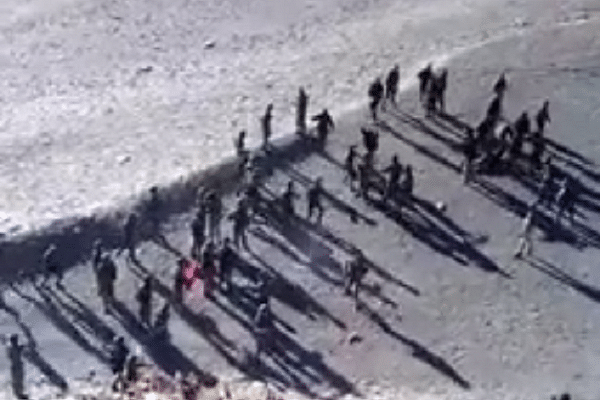India must be vigilant and at the same time prepare for the worst.
This Independence Day brought unexpected news of troops from China’s Peoples’ Liberation Army (PLA) pelting stones at Indo-Tibetan Border Police (ITBP) personnel at Pangong Tso. Many ITBP personnel were injured in the incident.
On August 19, 2017, a video of the incident emerged. At first glance the video confuses a viewer. It requires at least two viewings to understand that the Chinese soldiers crossed the limits of sane behaviour. They were not only pelting stones at ITBP personnel, but also hitting and kicking them. It was an unprecedented act and terrible behaviour by the Chinese PLA.
It was an impossible task to geo-locate the video after the first few viewings. However, the bright idea of stitching video frames together gives a panoramic view of the location.
The long shadows of the men and the fact the altercation took place in the morning narrowed the probability of the incident having taken place on the Northern shores of Pangong Tso. The incident obviously took place between two differently perceived borders.
The task became easier when the satellite images were seen with North-facing down. The video was geo-located to 33 43 12N 78 45 49E, which is very close to the perceived Chinese border. In the video, ITBP personnel are on the right and the PLA troops on the left. The ITBP personnel are seen carrying white banners to indicate to the PLA that they have violated patrolling lines.
PLA and jostling
The PLA using jostling to push the opposing army behind a border is not a new tactic. It was seen during the Ussuri River incident in 1969 when troops from China and the erstwhile USSR jostled in the snow.
The Indian Army experienced the same at Doklam area in June and July of 2017. But PLA troops pelting stones at ITBP personnel was unwarranted, and has never happened before.
Why the incident at Pangong Tso was an aberration
The incident would never have occurred if the PLA abided by the relevant treaties and agreements regarding the Pangong Tso area. The routine protocol for any visual sighting of opposing forces is being followed by the ITBP personnel — to show white banners; then convey the message on megaphones or loudspeakers. The physical interaction should never have taken place at all.
This video clearly puts the PLA in the dock. It is very clear and apparent that the Chinese resorted to physical violence first, and had some axe to grind after the Doklam standoff. The Chinese soldier jumping and kicking ITBP personnel from almost 2-4 metres above was uncalled for. Surely the Indian government will take this issue up with the relevant authorities in China.
Importance of the area
The area lies close to the Southern tip of Aksai Chin, that has been occupied by China since the 1962 war with India. Pangong Tso is sacred to Indians and Tibetans. Today, India controls less than one-third of the 160 km-long lake. There is no way Indians can hope to circumvent the lake in their lifetime.
Strategically, this area is very important because it provides access to the areas north of the Himalayas on the Tibetan plateau. Both China and India have deployed speedboats to patrol the lake.
South of the Pangong Tso and East Chushul, there is another freshwater lake named Spanggur Tso. It is presently under Chinese control and is the source of many jibes against Indian officers. At almost every Border Personnel Meeting, Indian officers are reminded that they can’t eat the freshwater fish of the Spanggur Tso.
What to watch for
All our forces must remain vigilant for the unexpected. It is a perpetual habit and tactic by the Chinese to open up new fronts if one is closed. China today knows that the Doklam issue has become a stalemate, and is not likely to be resolved. Hence, the PLA will make all efforts to grab land in areas that are sensitive to India, so that they can be used to strike bargains in either Ladakh or Arunachal Pradesh.
India must be vigilant and at the same time prepare for the worst — a war with its nuclear neighbour.
Col Vinayak Bhat (retd) is a Military Intelligence veteran of the Indian Army with vast experience of satellite imagery analysis. He has worked as Chinese interpreter and is a specialist on PLA and Pakistan’s Armed Forces. He tweets @rajfortyseven
